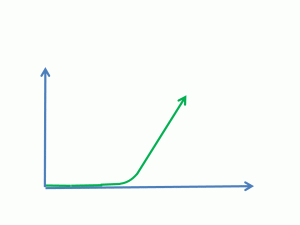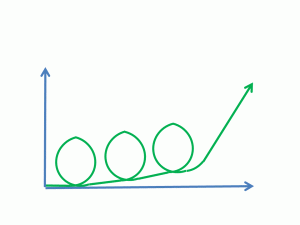Most real startups don’t grow like this:
 Instead, most successful startups grow like this:
Instead, most successful startups grow like this:
Those initial loops are unsuccessful attempts to create a product people want to use. The problem is those loops can take months and/or millions of dollars to get through, and many startups never get there. But a startup can get through at least one or two of those loops quickly, in a matter of a few short weeks, by using a new concept called Monetizable Pain.
The Nice-To-Have
On paper, in hindsight, those loops look like failures. In practice, in the trenches, it’s never so obvious. The loops always start off sounding like a good idea full of possibility. But before long, after development and launch, it becomes apparent that while interesting, the product is somehow not necessary enough, or useful enough, to really build a business around, even if it’s well designed. It’s merely a nice-to-have product, one that addresses what Paul Ahlstrom and Nathan Furr, in their new book Nail It Then Scale It, call a “mosquito bite”.
Nice-to-have products are often wonderfully designed and work well. An example is scanR. They built a nice mobile app that turns the camera on your phone into a wireless document scanner. Users liked it. Unfortunately the team ran into challenges building a business around the concept. ScanR, like many smart, capable startups, found that “like” does not easily convert into “here’s my credit card number.” (Just ask any business trying to measure ROI on FaceBook “Likes”.)
The Must Have
The part of the curve on the right, where things are finally looking up, is where a startup has figured out how to offer a must-have. This part arrives when the company gets two things right at the same time:
- It is now focused on monetizable pain – a problem that Furr and Ahlstrom refer to as a “shark bite”.
- It is offering a solution that provides a direct, meaningful level of relief for that problem. (Without adding too many new hassles in the process.)
It’s important to note that a viable solution in the must-have part of the curve is not necessarily a mainstream product like the classic model in Geoffrey Moore’s Crossing the Chasm. Nonetheless, the product begins to sell, and/or the users begin to grow. In my first startup, NetMind, our first customers were Boeing, eBay, IBM and the CIA and I promise you they did not fit the classic profile of an “early adopter” who is tolerant of a crappy product. They were not remotely interested in bleeding edge, early stage solutions. But they had monetizable pain, and we had something that provided real (albeit small, initially) relief. So they bought it. And that began a long journey that eventually ended in an $800 million acquisition.
The Must-Have Shortcut
Most of the good startup wisdom out there, from Lean Startup, to Customer Development, to Y Combinator, emphasize engaging customers early by building something that offers the product concept or a product feature and then measuring customer/user response. This method is way smarter and faster than the old startup (and current big company) process of building out a real product and hoping users come. However, there is a first step that can get you to must-have and product/market fit even faster.
Validate Monetizable Pain First
Offering a minimum viable product is a fantastic way to learn what target customers want. I do it all the time. The only problem is the learnings you get don’t always lead to a breakthrough product focused on monetizable pain. The reason?
Monetizable pain is about the customer’s problem, not the startup’s product.
For that reason, the first step on the road to product/market fit for any startup is to go deep on the customer problem and test for monetizable pain before building anything.
The monetizable pain discovery and testing methodology is quite aligned with Customer Development, except we’ve found it’s very beneficial to work through the monetizable pain process before (rather than concurrently with) initial product development. While it sounds heretical to delay development, the reality is no proposed product spec has ever survived the monetizable pain discovery process. It’s a process that forces the entrepreneur to know more about the problem than any one target customer, and it turns out that 100% of all product visions change during this step. And the process of locking on to monetizable pain does not have to take long – if you do it right.
How to Validate Monetizable Pain
Validating monetizable pain requires a method for measuring the value of a problem. It requires the development of a reliable metric for customer problems. Unfortunately the well known business metrics don’t really help us because they have much more to do with the solution side of the equation. For instance, one obvious business metric is sales. Sales can measure the success of a product. But nobody buys problems. (They unfortunately arrive free of charge.)
One way to accurately measure a customer problem is to rely on this principle:
The value of a problem directly correlates to the time people will take to tell you about it.
Time and time again we find that if busy people, who fit your target customer profile, are willing to give you valuable time simply to discuss a particular problem, with no clear promise (yet) of a viable solution, then you have an important problem. The kind of problem a startup, with limited resources, no brand, an incomplete product and a small team can actually sell into.
My Favorite Test for Monetizable Pain in B2B
Our favorite (and most dramatic) monetizable pain test has been proven to work well across a number of different B2B market segments. The B2C tests are different and very interesting as well. The posts on those are coming.
This B2B test works like this:
Place a true cold call to your hypothetical target customer – meaning the actual role/title of the person in the big name brand you would actually like to sell to – and leave a voice message that does little more than ask, “Do you have this problem?”
It sounds crazy. And even though I’ve done it a lot, I still get nervous making the calls. But if it is a monetizable pain problem, and you indeed say the problem the right way ( the right specific description using their jargon), to one of the people in the organization who most feels the problem, they call you back. In fact, we use a rule that its not monetizable pain unless 50% of the target customers call you back.
My marketing brethren find this hard to believe at first because they live in a world where a single digit response rate is celebrated. The monetizable pain test, however, is quite different. It’s not a marketing campaign. We’re not selling anything, even if at the end they want to buy. (Which sometimes happens, and that’s an important scenario that I’ll post about soon.)
In fact, there are key things to say in the call that make the differences clear. I will share more in the next post (sorry, I’m not trying to leave anyone hanging, just need to wrap this post.)
Four Important Words
There are important nuances to the call script, and very important structure to the short but sweet interview you do when they call back. For now, I’ll share the most important thing to say in the cold call – probably the four most important words after your problem description – “I’m not selling anything.” This sentence alone distinguishes the process and makes you sound completely different on the phone.
Beware
There is so much more to this so if you decide to try it on your own, please wait until I share more in the next post or contact me. Hopefully you have enough to be interested. Unfortunately this is not quite yet enough to give you meaningful data from the test yet.
Next up: real examples – real results.
Please share in the comments if you have ever tried cold calling target customers…..were you nervous?




This is great I wanna read the follow up…
An example of what to say in regards to script would be really helpful.
Also would like to know the B2C tests for monetizable pain
Wow, what a cliffhanger post! I’ll certainly be tuning in again for future episodes.
I love the scalable way this can test a pain point. With a potential 50% response rate, that is even amenable to some split testing.
I wish you have labeled the x/y axis on your graphs.
If x is time then congrats, you apparently have experienced using a time machine.
I would guess the X-axis is product development and the Y-axis is traction. You try out a few things and they seem kinda promising, but as you realize they won’t take you to where you need to go, you rewind things a bit, and start back over with something slightly different.
So… Was there ever a followup? This *does* sound like a really good idea…
Your version of the cold call sounds really interesting!
I cant wait for the follow up!
Eagerly waiting for your real examples!
Mark, thanks so much for writing this post. It’s actually a brilliant insight to customer development which makes a ton of sense. I’m developing a new product now and will definitely add this approach to evaluate customer development meetings.
To what extent can online discussion about a problem–be it in the news, blogs, or industry forums–serve as validation of monetizable pain? There’s probably nothing more valuable then talking to actual potential customers of course, and I’ve learned so much doing it, but how much does it really add to the research?
Hi, I like your approach – it is very modern (not so 19th century, as a lot of thoughts on this topic). My expirience with cold calling is this: The better mood I have, the better is my cold calling. NEVER call cold when you are in a sad, bad, bussy or whatever “negative” state of mind. On the one hand you sound great in good or even exciteted mood, so yout might be more sucessful. And on the other hand a negative answer doesn`t make you feel too bad and therefor able to call the next one. Thx for the text. akaJens
Exactly! I noticed that it’s always better to call with a positive state of mind. Think of your favorite time during a childhood or another really positive memory. You’ll do so much better!
I understand the “loops” part , in concept, but if the x-axis is time, then where you are showing the loops, the y-axis (which possibly represents something like growth, value etc) has 2 values i.e. if I were to draw a vertical line from these points on the x-axis it intersects the curve *twice* – maybe, a wavy curve would prove your point better?
This is great advice, but it’s hard to swallow when your time series graphs don’t make any sense!
Fascinating! Okay yes, I have to say that I am always happy to find a sales guy who actually hungers for these calls. I don’t personally get too nervous making the calls, but I also don’t do them too often either.
This is really awesome advice. I hope you will consider writing a new post soon. Thanks.
Mark,
Really appreciate you posting these – I know they take a lot of time, but your insights are hugely valuable in helping me and my biz partner build a more complete mental model of how to build a successful company.
Back in May when we were learning what to build by talking to potential customers, I cold called a bunch of customers and found that the four magic words worked wonders. It changed the tenor of every conversation and made customers feel comfortable about sharing their pain points.
Our more effective technique was to use some inbound marketing tactics to get qualified signups on a landing page with marketing copy. We then emailed those folks to set up a time to chat about their problems “to make sure built something they loved”. Most were receptive to talking on the phone. Asking those folks for referrals was how we ended up speaking to 30+ potential customers, and getting financial commitments from a number of them, before writing a single line of code. The inbound marketing tactics and warm leads it generated had the added benefit of fewer sphincter-tightening cold-calls; the downside is that it took a little longer than just picking up the phone 🙂
Please keep up the great posts!
Kareem
Follow up soon? The waiting is killing me..
Hi, marvelous post. I’m currently building an apps but got little guidance on how to test the willingness of our potential users to use this apps. This post made it clear, definitely waiting for the next series.
I want to discuss about the 4 magic words “I’m not trying to sell anything”. If those magic words is stated, does it means that the cold call will flows like a survey, without saying any words like “we are currently building a product to address that”?
PS: Sorry for my bad english.
What an insightful post! Thanks for showing me that I’m on the right track…I have ‘cold-called’ (most of the time, I had a cold-conversation) some of my future customers and have noticed that they are willing to share a problem. I have been building this product around some of the potential customers’ feedback and I’m crossing my fingers it will work. I’m an introvert and it takes me a while to open up to people, so I was definitely nervous doing those things. However, I find that the feedback you get is invaluable (evident by your post). Can’t wait for part two!
Wonderful. As someone that has done over twenty thousand cold calls (probably more) this is wonderful insight. I sent this article to our senior leadership team and said: ‘ this is the roadmap for 2012.’
can’t wait for the next post in the series, these have been very helpful. thanks !
Great post. We will be taking your suggestions and incorporating them into some existing client calls this week…and, making some cold calls to see what kind of measured reaction we get on the pain-o-meter. Would love to see the follow-up posts on this? thanks!
While I agree the shortest path to product/market fit is best, I think an MVP or prototype is required to really sell the story to a potential customer.
In my experience, too often a potential customer only “gets it” when they see the product spring to life in front of them.